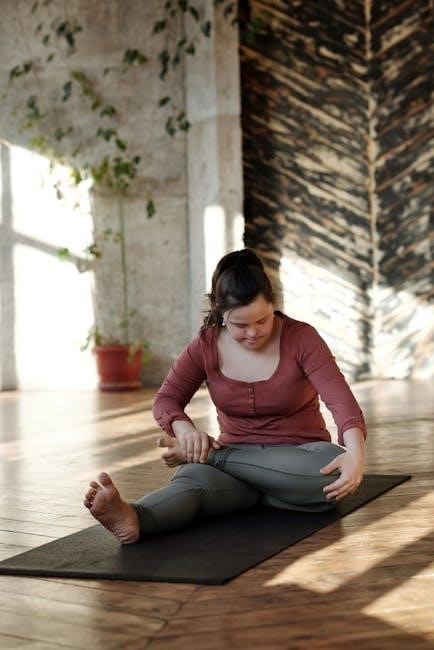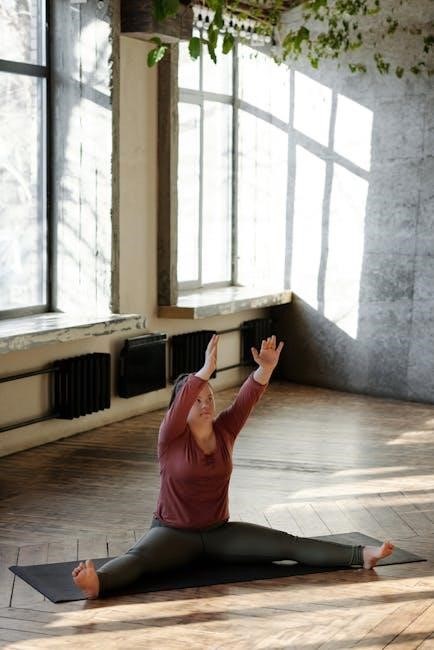ITBS is a common overuse injury causing knee pain, especially in runners and cyclists. It occurs when the iliotibial band becomes inflamed or irritated.
1.1 Definition and Overview of ITBS
Iliotibial Band Syndrome (ITBS) is a common overuse injury characterized by inflammation of the iliotibial band, a fibrous tendon running from the hip to the knee. This condition often causes pain on the outer side of the knee, especially during activities like running or cycling. ITBS typically arises from repetitive friction between the IT band and the thigh bone or knee. It is frequently diagnosed in athletes and individuals with poor hip or knee mechanics. Early intervention, including stretching and rest, is crucial for effective management.
1.2 Common Causes and Risk Factors
ITBS is often caused by repetitive activities such as running, cycling, or hiking. Weak hip muscles, poor running mechanics, and inadequate warm-ups can contribute to its development. Overuse injuries, tight IT bands, and improper footwear also increase the risk. Additionally, activities involving repetitive knee bending or direct pressure on the IT band can exacerbate symptoms. Identifying and addressing these factors is key to preventing and managing ITBS effectively. Regular stretching and strengthening exercises can help mitigate these risks.
1.3 Importance of Stretching in ITBS Management
Stretching is crucial for reducing tension in the IT band, alleviating pain, and improving flexibility. Regular stretching helps maintain range of motion and prevents tightness, which can worsen symptoms. It is a key component of ITBS recovery and prevention. Gentle stretches, such as crossing the legs or using a wall for support, can be done at home. Consistent stretching, combined with proper technique, enhances healing and reduces the risk of recurrence, making it essential for long-term management of ITBS.
Symptoms and Diagnosis of ITBS
ITBS typically causes pain on the outer side of the knee, especially during activities like cycling or running. A healthcare provider diagnoses it through physical examination and tenderness assessment.
2.1 Identifying Pain on the Outer Side of the Knee
Pain on the outer side of the knee is a hallmark symptom of ITBS. It often worsens with repetitive activities like cycling or running. The discomfort may radiate along the iliotibial band, from the hip to the knee. Tenderness is usually felt when pressing on the lateral aspect of the knee. This pain can be sharp or a dull ache, especially during movements like climbing stairs or squatting. Proper identification is crucial for effective management through stretches and exercises.
2.2 How ITBS is Diagnosed by Healthcare Providers
Diagnosis of ITBS typically involves a physical examination to assess pain and tenderness along the iliotibial band. Healthcare providers may use the Ober test to evaluate hip tightness and pain on the lateral knee. Palpation of the IT band, especially during activities like squatting or cycling, can confirm discomfort. Imaging, such as X-rays or MRIs, may be used to rule out other knee injuries. A thorough clinical evaluation is essential to accurately diagnose ITBS and differentiate it from other knee conditions.

Benefits of Stretching for ITBS
Stretching reduces muscle tension, improves flexibility, and prevents ITBS recurrence. It enhances hip and knee mobility, aiding in effective rehabilitation and symptom relief.
3.1 Reducing Tension in the IT Band
Stretching effectively reduces tension in the IT band, alleviating tightness and discomfort. Regular stretching improves flexibility, prevents irritation, and enhances overall muscle function. This helps in managing ITBS symptoms and supports long-term recovery.
3.2 Improving Hip and Knee Flexibility
Stretching exercises targeting the IT band and surrounding muscles significantly enhance hip and knee flexibility. Improved flexibility reduces stiffness and promotes smoother joint movement, which is crucial for managing ITBS symptoms. Regular stretches, such as the standing IT band stretch and seated stretches, help alleviate tightness and restore normal range of motion. This, in turn, reduces the risk of further irritation and supports overall lower limb function. Enhanced flexibility also aids in preventing recurrence of the syndrome.
3.3 Preventing Recurrence of ITBS
Consistent stretching and foam rolling are key to preventing ITBS recurrence. Strengthening hip muscles, especially abductors, helps stabilize the pelvis and reduces strain on the IT band. Activity modification, such as adjusting cycling resistance and maintaining proper workout form, also plays a crucial role. Incorporating rest and recovery, including ice therapy, allows the IT band to heal and rebuild resilience. Regular exercise routines and proper warm-ups can significantly lower the risk of experiencing ITBS symptoms again, promoting long-term relief and mobility.

Standing Stretches for ITBS
Standing stretches target the IT band effectively. Cross your uninjured leg over the affected leg, bend to touch your toes, and hold for 30 seconds. Repeat three times.
4.1 Standing IT Band Stretch
Start by standing near a wall for balance. Cross your uninjured leg over the affected leg, keeping the affected leg straight. Bend forward at the hips to stretch the IT band. Hold for 30 seconds, feeling the stretch on the outer thigh. Repeat 3 times. This stretch helps reduce tension and improve flexibility in the IT band, alleviating knee pain and discomfort associated with ITBS.
4.2 Cross-Leg Stretch for the Affected Leg
Sit on the floor with your legs straight. Cross the affected leg over your uninjured leg, placing the ankle on the knee. Gently lean forward from the hips until you feel a stretch on the outer thigh. Hold for 30 seconds, then return to the starting position. Repeat 3 times. This stretch targets the IT band and surrounding muscles, helping to relieve tension and improve mobility, which is essential for managing ITBS symptoms effectively.

Seated and Floor-Based Stretches
Seated stretches, like the figure-four stretch, target the IT band and hips, improving flexibility. Floor-based stretches allow for deeper stretches, reducing tension in the IT band effectively.
5.1 Seated IT Band Stretch
The seated IT band stretch is a simple yet effective exercise to relieve tension. Sit on the floor with your legs extended. Cross your affected leg over your unaffected leg, placing your foot on the opposite thigh. Gently lean forward from your hips until you feel a stretch on the outer side of your thigh. Hold for 20-30 seconds and repeat 2-3 times. This stretch targets the IT band, improving flexibility and reducing tightness without causing discomfort.
5.2 Figure-4 Stretch for Hip Flexibility

Dynamic Stretches for ITBS
Dynamic stretches enhance blood flow and flexibility, reducing IT band tension. They involve controlled movements like leg swings and lateral lunges, improving joint mobility and strength.
6.1 Leg Swings for Hip Mobility
Leg swings are a dynamic stretch that improves hip mobility and reduces IT band tension. Stand with your injured leg free, swing it forward and backward, then side to side. Perform 2 sets of 15-20 swings in each direction. This exercise enhances joint lubrication and flexibility, making it ideal for pre-workout or post-activity recovery. Regular practice can help prevent ITBS recurrence and maintain optimal hip function.
6.2 Lateral Lunges to Target the IT Band
Lateral lunges effectively target the IT band while improving hip and knee flexibility. Stand tall, take a large step to one side, and lower your body until your back knee nearly touches the ground. Keep your front knee over your ankle and your weight in your heels. Push back to the starting position and repeat on the other side. Perform 2 sets of 10-12 reps per leg. This exercise strengthens the hip abductors and reduces IT band tightness, helping to prevent ITBS.

Foam Rolling Techniques
Foam rolling reduces IT band tension and improves circulation. Use a foam roller to gently roll the IT band and surrounding muscles daily to alleviate pain and prevent recurrence.
7.1 Foam Rolling the IT Band
Foam rolling the IT band helps reduce tension and improve circulation. Using a foam roller, gently roll along the outer thigh, focusing on the area from the hip to the knee. Roll slowly, applying moderate pressure, and pause on tender spots to release tension. This technique can be done daily to alleviate pain and prevent IT band tightness. Regular foam rolling complements stretching and strengthens the surrounding muscles, promoting recovery and reducing the risk of ITBS recurrence.
7.2 Foam Rolling the Surrounding Muscles
Foam rolling the muscles around the IT band, such as the quadriceps, hamstrings, and hip flexors, enhances flexibility and reduces overall tension. Start by rolling the quadriceps, focusing on the front of the thigh, then move to the hamstrings at the back. For the hip flexors, roll gently near the hip bone. This comprehensive approach ensures that tightness in adjacent areas doesn’t contribute to IT band strain. Regular foam rolling of these muscles supports recovery and prevents ITBS recurrence by maintaining balanced muscle tension and promoting blood flow.

Strengthening Exercises to Complement Stretching
Strengthening the hip abductors and core muscles is crucial for stabilizing the hip and knee, reducing ITBS recurrence. Focus on exercises targeting the glutes and hip abductors.
8.1 Strengthening the Hip Abductors
Strengthening the hip abductors, such as the gluteus medius and minimus, is essential for improving hip stability and reducing ITBS symptoms. Weakness in these muscles can lead to poor running or cycling mechanics, increasing stress on the IT band. Exercises like side-lying leg lifts, clamshells, and banded lateral walks target these muscles effectively. Perform 2-3 sets of 15-20 repetitions daily to build strength and endurance. Consistency in these exercises helps prevent ITBS recurrence and enhances overall lower limb alignment.
8.2 Core Strengthening for Better Stability
A strong core enhances pelvic and lower limb stability, reducing ITBS risk. Exercises like planks, bird dogs, and Russian twists target abdominal and back muscles. Perform 2-3 sets of 15-20 reps daily; Improved core stability promotes better movement patterns, minimizing IT band strain. Strengthening these muscles helps maintain proper alignment during activities, alleviating pressure on the knee. Consistency in core exercises supports long-term ITBS management and overall athletic performance. This foundational strength is crucial for preventing recurrence and enhancing mobility;

Rehabilitation Exercises for ITBS
Rehabilitation focuses on restoring strength, mobility, and function to address ITBS. Targeted exercises help improve hip and knee mechanics, reducing pain and preventing recurrence.
9.1 Step-by-Step Rehabilitation Program
A structured program begins with gentle stretching, like standing IT band stretches, progressing to strengthening exercises for hip abductors and core muscles. Initially, patients perform basic exercises, such as leg swings and seated stretches, to improve flexibility and strength without aggravating symptoms. As tolerance increases, dynamic stretches and functional movements, like lateral lunges, are introduced to enhance mobility and stability. Regular foam rolling of the IT band and surrounding muscles is also encouraged to reduce tension and promote healing. Consistency and proper form are emphasized to avoid setbacks.
9.2 Progressing from Basic to Advanced Exercises
As symptoms improve, progress from basic stretches like leg swings and seated IT band stretches to more dynamic exercises. Incorporate lateral lunges and step-ups to strengthen the hips and improve stability. Advanced exercises focus on functional movements, such as single-leg balances and resisted band walks, to mimic real-life activities. Gradually increase intensity by adding resistance or depth to movements. Foam rolling and strengthening exercises for hip abductors should continue, with a focus on proper form and controlled execution to prevent recurrence. Adjust frequency and intensity based on tolerance.

Preventing ITBS Through Activity Modification
Modify activities by adjusting cycling resistance and maintaining proper form to reduce strain on the IT band. This helps prevent irritation and recurrence of symptoms.
10.1 Adjusting Cycling Resistance
Reducing cycling resistance can help minimize strain on the IT band, preventing tightness and irritation. Cyclists should avoid high resistance settings that overengage the outer thigh muscles. By lowering resistance, riders can maintain a steady cadence without overloading the IT band. This adjustment is particularly beneficial for those prone to ITBS, as it reduces repetitive friction on the band. Starting with lower resistance and gradually increasing as symptoms improve can help manage discomfort and promote healing. Proper bike fit and technique also play crucial roles in preventing ITBS.
10.2 Maintaining Good Form During Workouts
Maintaining proper form during workouts is essential to prevent ITBS. Poor form can lead to uneven stress on the IT band, causing irritation and pain over time. For runners, ensuring a midfoot strike and avoiding overstriding can reduce strain. Cyclists should focus on proper knee alignment and avoid leaning too far forward, which can compress the IT band. Strengthening core and hip muscles also helps maintain good form by providing stability and reducing biomechanical inefficiencies that contribute to ITBS. Awareness of body positioning can significantly lower the risk of developing symptoms.

The Role of Rest and Recovery
Rest is crucial for healing ITBS, allowing the inflamed IT band to recover. Ice therapy reduces pain and inflammation, aiding in faster recovery and preventing further damage.
11.1 Importance of Rest in Healing
Rest is crucial for healing ITBS, as it allows the inflamed iliotibial band to recover without further irritation. Avoiding activities that aggravate the condition prevents prolonged inflammation. Ice therapy, applied periodically, can reduce pain and swelling, promoting faster recovery. Adequate rest, combined with targeted stretching and strengthening exercises, helps restore normal function and prevents recurrence of the syndrome. It is essential to balance activity modification with rest to ensure proper healing and return to full mobility.
11.2 Using Ice Therapy for Pain Relief
Ice therapy is a proven method to reduce pain and inflammation associated with ITBS. Applying an ice pack wrapped in a towel to the affected area for 15–20 minutes, 2–3 times daily, can significantly alleviate discomfort. This technique helps numb the area, reducing pain and swelling; It is often recommended in conjunction with rest and stretching exercises to enhance recovery. Always use a protective barrier, like a towel, to prevent skin damage. Consistent use of ice therapy can lead to faster healing and improved mobility.
Effective management of ITBS involves a combination of stretching, strengthening, and activity modification. Consistent use of rest, ice therapy, and targeted exercises promotes long-term relief and recovery.
12.1 Summary of Key Stretching and Strengthening Techniques
Key stretching techniques include standing IT band stretches, cross-leg stretches, and seated figure-4 stretches to improve flexibility. Dynamic stretches like leg swings and lateral lunges enhance mobility. Foam rolling the IT band and surrounding muscles reduces tension. Strengthening exercises focus on hip abductors and core stability to address imbalances. Activity modifications, such as adjusting cycling resistance and maintaining proper form, prevent recurrence. These techniques, when combined with rest and ice therapy, provide a comprehensive approach to managing ITBS effectively.
12.2 Final Tips for Managing ITBS
Consistently incorporating stretching, strengthening, and foam rolling routines is crucial for long-term relief. Gradually increase activity levels to avoid overuse, and prioritize proper form during workouts. Rest and ice therapy are essential for acute pain management. Maintain a balanced approach by combining flexibility exercises with strengthening programs. Educating oneself on ITBS prevention strategies ensures sustained recovery and reduces recurrence risk. Stay proactive with regular maintenance exercises to enjoy pain-free movement and optimal performance in sports and daily activities.
